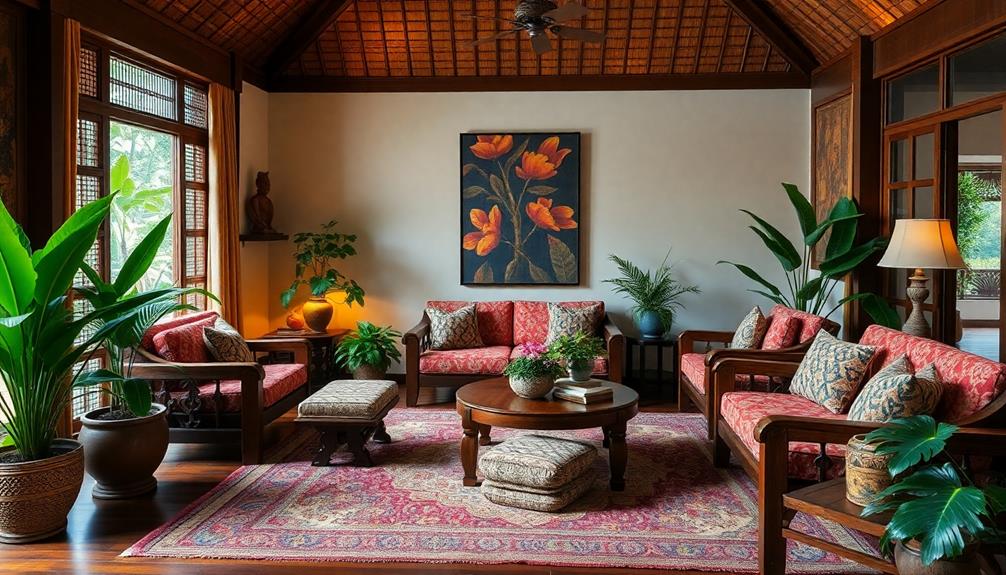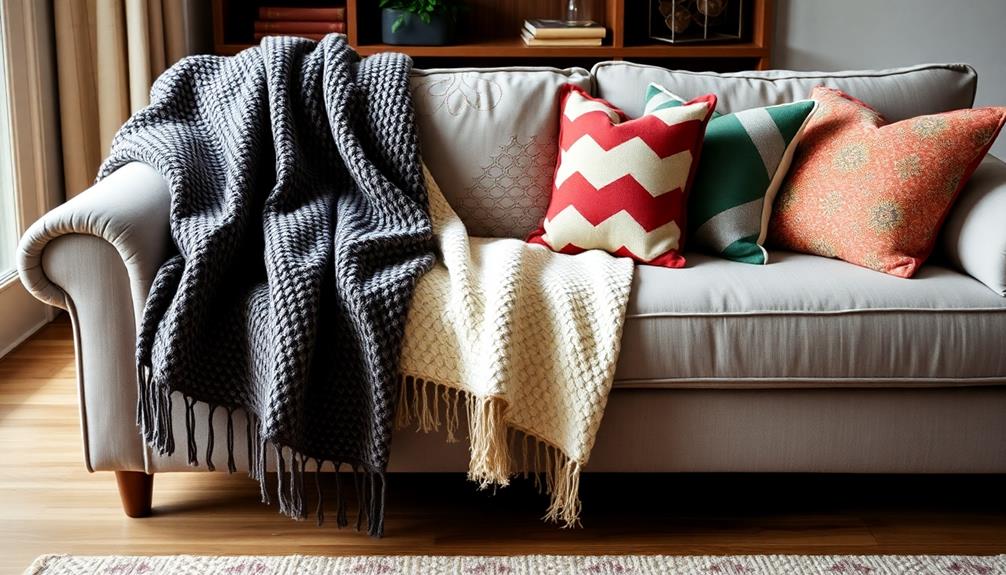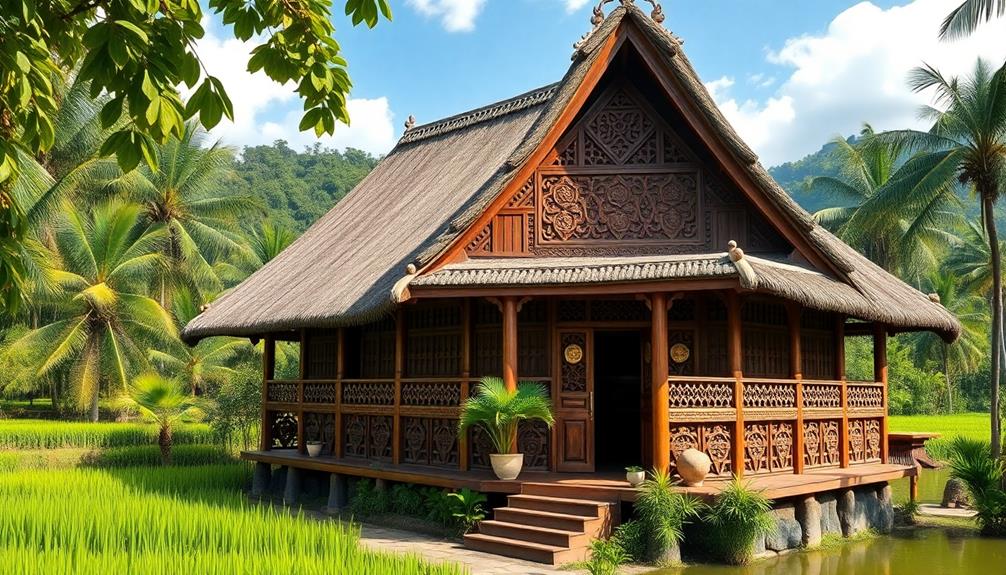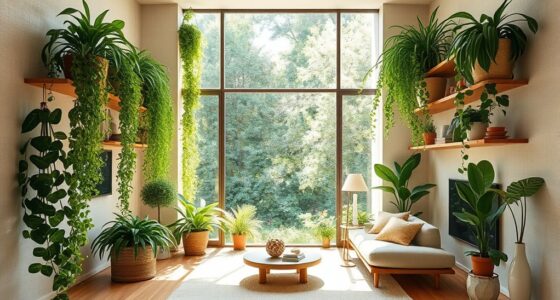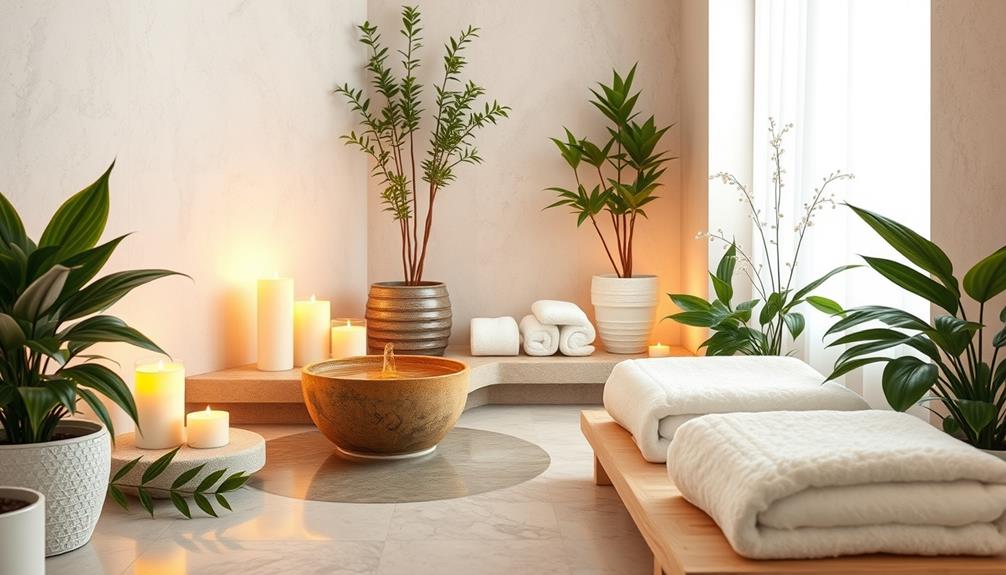Authentic Indonesian design embodies the vibrant essence of Indonesia’s cultural heritage. It blends traditional elements with modern aesthetics, showcasing rich colors and natural materials such as rattan and bamboo. The key to this style lies in the use of handcrafted textiles like batik and ikat, which bring texture and warmth. Balance and harmony are fundamental principles that foster tranquility in your living spaces. Adding local artifacts enhances the story of your home. By embracing these elements, you can create welcoming environments that tell the tale of Indonesia’s past. Stay tuned, as there is much more to discover about achieving this captivating style!
Key Takeaways
- Authentic Indonesian design celebrates cultural heritage through vibrant colors and traditional textiles, reflecting the diverse archipelago's unique practices.
- Natural materials like rattan and bamboo enhance sustainability and create inviting atmospheres while honoring Indonesia's rich artisanal traditions.
- Integrating traditional textiles, such as batik and ikat, adds depth and visual storytelling to interior spaces, supporting local artisans.
- Balance and harmony are essential principles in Indonesian design, promoting tranquility through symmetry and thoughtful placement of cultural artifacts.
- Nature integration techniques, such as incorporating greenery and maximizing natural light, enhance the connection between interiors and the environment.
Cultural Significance of Indonesian Design
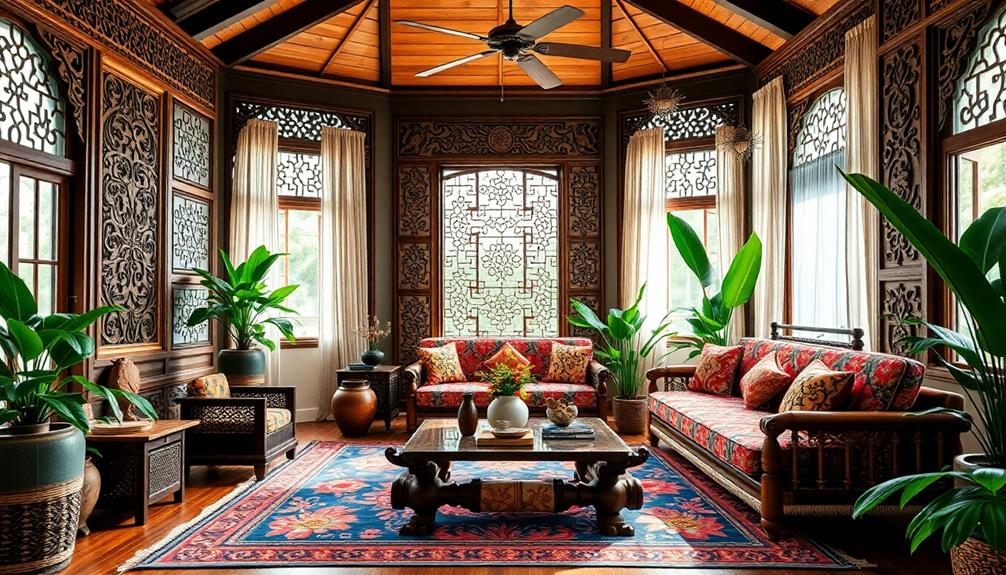
There's something truly special about Indonesian design, as it captures the essence of the country's rich cultural heritage. When you explore this design style, you'll notice how deeply it's rooted in diverse cultural traditions. Each element reflects the unique practices of various ethnic groups throughout the archipelago, showcasing the stories and values that shape Indonesian identity. Indonesian design principles often emphasize harmony with nature, incorporating organic materials like bamboo, wood, and rattan to create warm, inviting spaces. These principles also highlight intricate craftsmanship, where attention to detail and symbolic motifs honor the traditional art forms passed down through generations. Ultimately, Indonesian design is a celebration of the country’s deep connection to both its environment and its vibrant cultural history.
For instance, the intricate details of Indonesian decor masks illustrate the artistic expressions that define this culture. Traditional artifacts like masks and sculptures play a vital role in this narrative, as they symbolize the spiritual beliefs and social customs of the Indonesian people.
These pieces aren't just decorative; they enhance the cultural authenticity of any space you create. As you incorporate vibrant colors and textiles such as batik and ikat, you'll find that they echo Indonesia's lush landscapes, making your surroundings a true celebration of its heritage.
Moreover, Indonesian design principles prioritize harmony and balance, reminding you of the essential connection between humans, nature, and the divine. As you embrace these cultural traditions, consider how they can transform your living environment into a soulful and inviting space, rich in meaning and history.
Key Elements of Indonesian Aesthetics
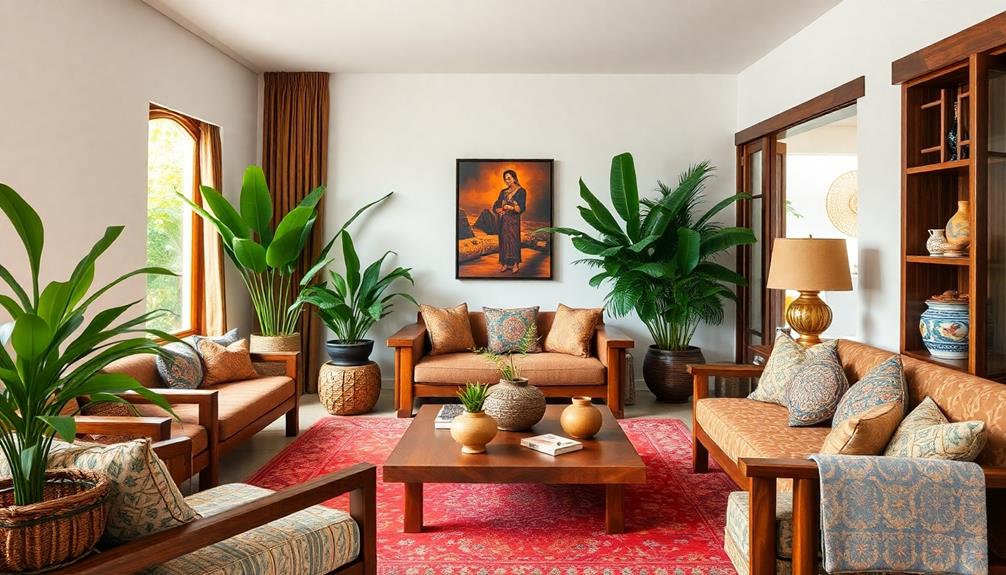
When you explore Indonesian aesthetics, you'll notice the deep-rooted influence of cultural heritage in every detail.
The vibrant color combinations, inspired by local landscapes and textiles, bring energy and life to spaces. Additionally, the use of handcrafted elements, such as Indonesian decorative pillows, enhances comfort while reflecting rich traditions.
Plus, the use of natural materials like rattan and bamboo creates a connection to the environment that's central to Indonesian design.
Cultural Heritage Influence
Indonesian aesthetics often draw on the archipelago's rich cultural heritage, blending traditional craftsmanship with diverse ethnic influences. This unique fusion showcases intricate craftsmanship that reflects the cultural identity of various regions. Each piece of furniture or decor tells a story, enriched by traditional elements that honor Indonesia's heritage.
| Element | Description | Cultural Significance |
|---|---|---|
| Intricate Carvings | Detailed patterns in wood and textiles | Reflect historical narratives |
| Natural Materials | Use of rattan, bamboo, and antique wood | Emphasizes sustainability and warmth |
| Cultural Artifacts | Masks, sculptures, and textiles | Visual narratives of artistry |
| Color Palette | Rich reds and deep blues | Embody energy and diversity |
Vibrant Color Combinations
Vibrant color combinations play an essential role in defining Indonesian aesthetics, infusing spaces with energy and warmth. You'll often find rich reds, deep blues, and earthy tones that reflect the beauty of local textiles and landscapes. These vibrant colors create a dynamic atmosphere, making any room feel alive and inviting.
Additionally, Balinese design characteristics emphasize the harmonious blend of tradition and modern aesthetics, which can further enhance your interior's vibrancy.
Incorporating traditional art forms, like batik prints and ikat patterns, enhances the cultural identity of your interior. These patterns not only add authenticity but also serve as a focal point for your design.
Combining bright hues with natural elements can transform a space, creating a harmonious balance that resonates with Indonesia's diverse heritage.
Layering textures through textiles—think rugs and tapestries—works wonders in enriching visual appeal. When these textures interact with bold color combinations, they invite touch and curiosity, making your home feel more engaging.
Ultimately, the thoughtful selection of colors reflects the aesthetic values of Indonesian culture and promotes a sense of balance and harmony within your living spaces. Embracing these vibrant color combinations will elevate your interior design, celebrating the richness of Indonesian aesthetics.
Natural Material Usage
Natural materials frequently take center stage in Indonesian interior design, creating a warm and inviting atmosphere. You'll often find elements like rattan, bamboo, and antique wood, each contributing to a sense of organic beauty. This emphasis on natural materials reflects a profound connection to the environment, promoting sustainability and eco-friendliness in your living spaces.
Additionally, the integration of traditional Indonesian style home decor enhances the overall aesthetic by incorporating intricate carvings and textiles, further enriching the interior experience. These elements not only bring a sense of cultural heritage but also create a warm and inviting atmosphere. For those looking to explore the **best Indonesian decor nearby**, local artisans and specialty shops often offer a variety of handcrafted pieces that reflect the archipelago’s rich traditions. Incorporating these authentic items adds a unique and personal touch to any living space.
Layered textures from rugs and tapestries made of organic fibers enhance the aesthetic, adding depth and comfort. When you choose these materials, you not only beautify your home but also support traditional craftsmanship. Artisans utilize age-old techniques, showcasing Indonesia's rich cultural heritage in every piece.
Incorporating these natural elements fosters a harmonious relationship between you and your surroundings, aligning with the principles of balance that underpin Indonesian design. By embracing these key elements, your interiors can transform into serene retreats, where the beauty of nature and cultural legacy come together.
Ultimately, the thoughtful use of natural materials allows you to create spaces that aren't only visually striking but also infused with meaning and history.
Understanding Indonesian Color Trends
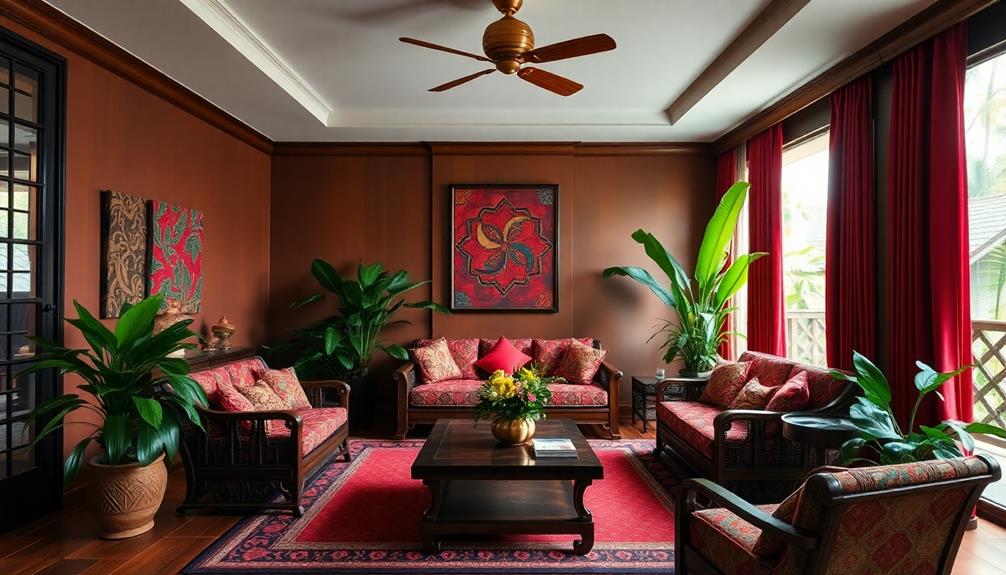
Color plays a pivotal role in defining the essence of Indonesian design, drawing inspiration from the country's breathtaking landscapes and rich cultural heritage. You'll notice that Indonesian color trends embrace vibrant hues, prominently featuring deep reds, blues, and earthy tones.
These earthy tones reflect a strong connection to nature, creating an inviting atmosphere in your space. Additionally, the use of traditional artistry in decor, such as handcrafted masks, can further enhance the cultural depth of your interior.
Traditional batik and ikat patterns greatly contribute to this colorful palette, infusing authenticity and cultural identity into your interior design. When you incorporate these textiles, you're not just adding color; you're celebrating Indonesia's artistic traditions.
Layering colors with various textures enhances visual interest and embodies the essence of Indonesian craftsmanship. Think about mixing textiles, like cushions or throws, with painted walls or furniture to create a dynamic look that feels alive.
The strategic application of these vibrant colors fosters energy within your spaces, allowing you to experience the warmth and vibrancy of Indonesian culture every day.
Embrace these trends to create an atmosphere that resonates with beauty and authenticity, reflecting the rich heritage and natural beauty that Indonesia has to offer.
Importance of Natural Materials
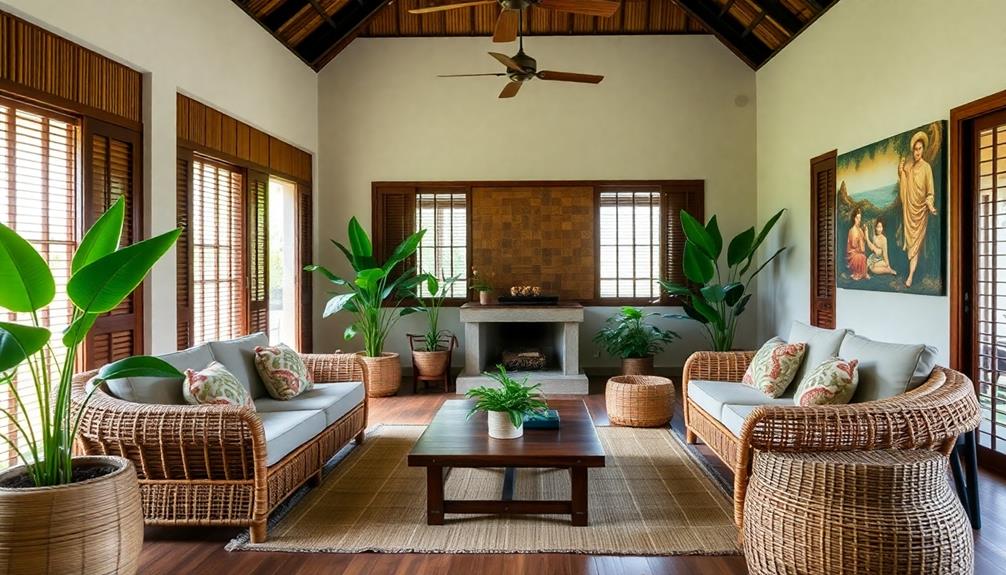
When you step into an Indonesian-inspired space, the warmth and authenticity of natural materials like rattan, bamboo, and antique wood instantly draw you in.
These elements are foundational in traditional design, providing not just visual appeal, but also a profound connection to the environment. By embracing natural materials, you're celebrating Indonesia's rich cultural heritage while promoting sustainability.
Many interior design experts, such as Mahallati Interiors, focus on blending these natural materials with modern luxury, enhancing both aesthetic and functionality in tropical living spaces.
Consider these benefits of using natural materials in your space:
- Aesthetic Appeal: Their organic beauty adds depth and character, creating an inviting atmosphere.
- Sustainability: Often sourced locally, these materials are biodegradable, reducing your ecological footprint.
- Cozy Atmosphere: Layered textures from rugs and tapestries enhance comfort, making spaces feel lived-in and warm.
- Respect for Nature: Incorporating natural materials reflects a deep respect for the environment, a core principle in Indonesian design philosophy.
Integrating Traditional Textiles
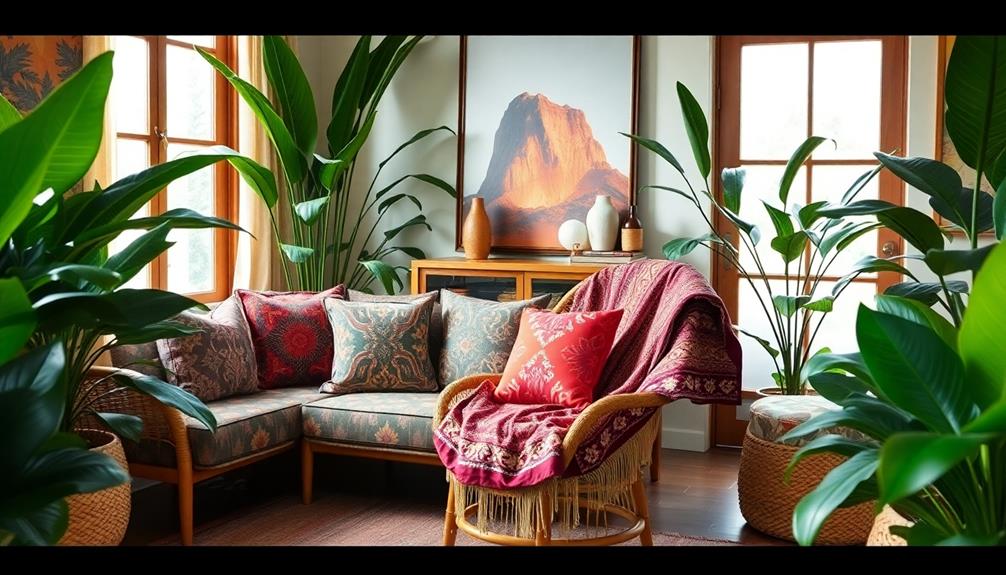
Traditional Indonesian textiles, like batik and ikat, bring life and character to any interior space. You can easily integrate these traditional textiles to create a warm and inviting atmosphere. Batik's intricate patterns offer storytelling through its designs, while ikat's dynamic blurred effects add artistic flair. By layering these textiles—think batik cushions, ikat curtains, and woven rugs—you celebrate Indonesia's diverse artistry.
Here's a quick overview of how you can incorporate these textiles into your home:
| Textile Type | Key Features | Ideal Uses |
|---|---|---|
| Batik | Wax-resist dyeing, unique patterns | Cushions, wall art, table runners |
| Ikat | Tie-dyeing process, blurred designs | Curtains, throws, upholstery |
| Woven Rugs | Handcrafted, various textures | Floor coverings, accent pieces |
Integrating these textiles not only enhances your home's visual appeal but also supports local artisans and preserves traditional craftsmanship. So, go ahead and transform your space with the vibrant stories and rich heritage of traditional textiles!
Role of Cultural Artifacts
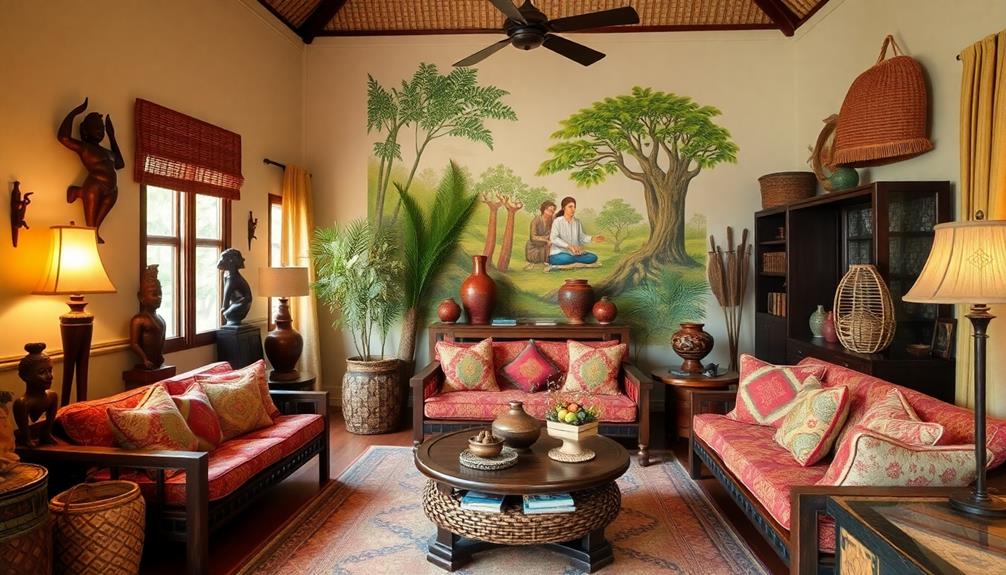
Incorporating cultural artifacts into your space adds depth and narrative to your interior design, complementing the vibrant textiles you've chosen.
These pieces, like traditional masks and sculptures, serve as focal points that tell stories and connect you to Indonesia's rich artistic heritage. Each artifact reflects the craftsmanship and historical significance of various regions, enhancing the visual appeal of your environment.
Additionally, the importance of Indonesian decor masks can't be understated, as they represent local myths and folklore while enhancing aesthetic appeal.
Here are some key ways cultural artifacts impact your space:
- Visual storytelling: They narrate the diverse cultural traditions that shape Indonesia's identity.
- Craftsmanship appreciation: Each piece showcases the unique skills of local artisans.
- Cultural connection: Artifacts foster a deeper bond between inhabitants and their roots.
- Immersive environment: They create a space that celebrates Indonesia's vibrant history.
Principles of Balance and Harmony
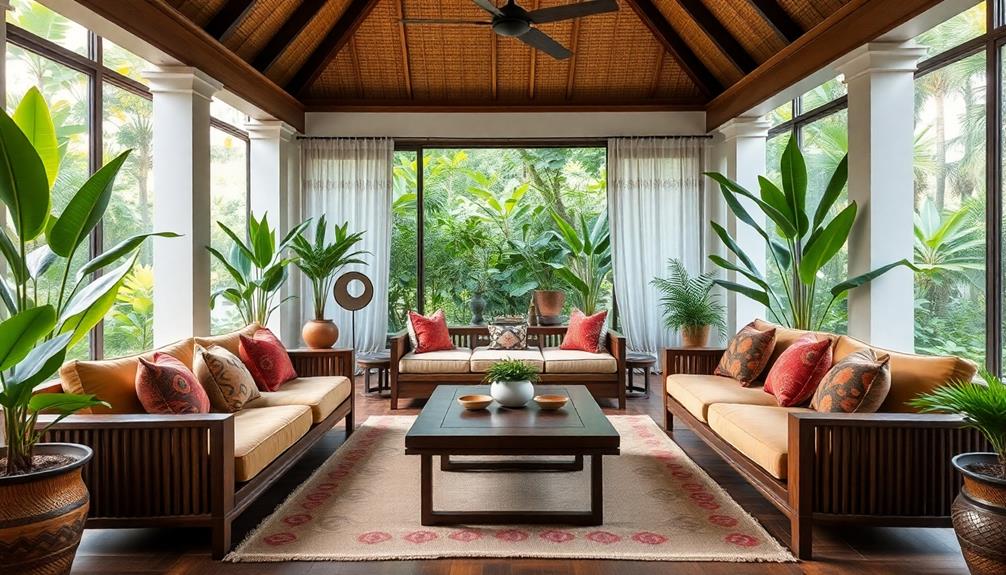
In Indonesian design, achieving balance and harmony starts with symmetry in your layout.
You'll notice how integrating natural elements connects your space to the environment, creating a serene atmosphere.
The emphasis on blending indoor and outdoor environments, as seen in modern tropical aesthetics, enhances this connection.
Plus, placing cultural artifacts thoughtfully enhances the overall aesthetic, reflecting a rich heritage while fostering a sense of tranquility.
Symmetry in Design
Emphasizing balance and harmony, symmetry plays an essential role in Indonesian interior design. It reflects the equilibrium between humans, nature, and the divine. By using symmetrical layouts, you can create calm and order in your living spaces, fostering a sense of peace.
Incorporating elements from Indonesian wedding decor can also enhance the cultural significance of your design. Traditional motifs, such as intricate batik patterns or the use of vibrant flowers like jasmine and orchids, can create a rich, immersive atmosphere reminiscent of age-old customs. Lighting elements, including ornate lanterns or candle holders, can further add to the charm, creating a warm and inviting ambiance. These touches can even blend seamlessly with **Indonesian restaurant design ideas**, where elements of authenticity meet modern celebration settings.
Here are key aspects to evaluate when incorporating symmetry in your design:
- Furniture Arrangement: Position furniture pieces evenly across the room to enhance balance.
- Natural Materials: Utilize wood, rattan, and other materials to reinforce visual harmony and tactile experiences.
- Decorative Elements: Arrange traditional masks and sculptures symmetrically to enrich the storytelling aspect of your space.
- Cultural Heritage: Embrace Indonesia's rich traditions by integrating symmetrical designs that echo historical practices.
Achieving symmetry not only boosts aesthetic appeal but also deepens your connection to Indonesia's cultural heritage.
Nature Integration Techniques
Harnessing the beauty of Indonesia's natural landscapes, nature integration techniques are essential for achieving balance and harmony in your interior design. By emphasizing the use of natural materials like bamboo and rattan, you foster a strong connection to the environment, reflecting Indonesia's deep reverence for nature in your space.
This approach resonates with the traditional Indonesian housing practices, where local materials are central to design, as seen in the traditional Indonesian housing styles.
Integrating plants and allowing natural light to flood your interiors enhances harmony, creating a soothing atmosphere reminiscent of Indonesia's lush landscapes. When arranging furniture, follow traditional principles that guarantee balance, allowing for both functionality and a peaceful flow throughout your living areas.
Layering textures with rugs and tapestries adds visual richness while respecting indigenous craftsmanship and aligning with the principle of organic beauty. You can also enhance tranquility by incorporating elements like water features or natural stone, further deepening your connection to nature within your home.
Ultimately, these nature integration techniques not only celebrate Indonesia's cultural heritage but also create an interior environment that feels alive, serene, and in perfect harmony with the world outside.
Cultural Element Placement
When arranging your space, consider the thoughtful placement of cultural artifacts like traditional masks and sculptures to achieve balance and harmony.
These elements don't just add character; they create visual balance that can transform your environment into a serene sanctuary.
To enhance your interior design, keep these principles in mind:
- Layered textures: Incorporate rugs and tapestries to create a cohesive visual flow.
- Natural materials: Use rattan and bamboo to introduce comfort and organic beauty.
- Vibrant colors: Integrate colors inspired by local textiles to energize your space while maintaining harmony.
- Symmetry: Position artifacts symmetrically to promote a sense of order and tranquility.
Creating Inviting Spaces
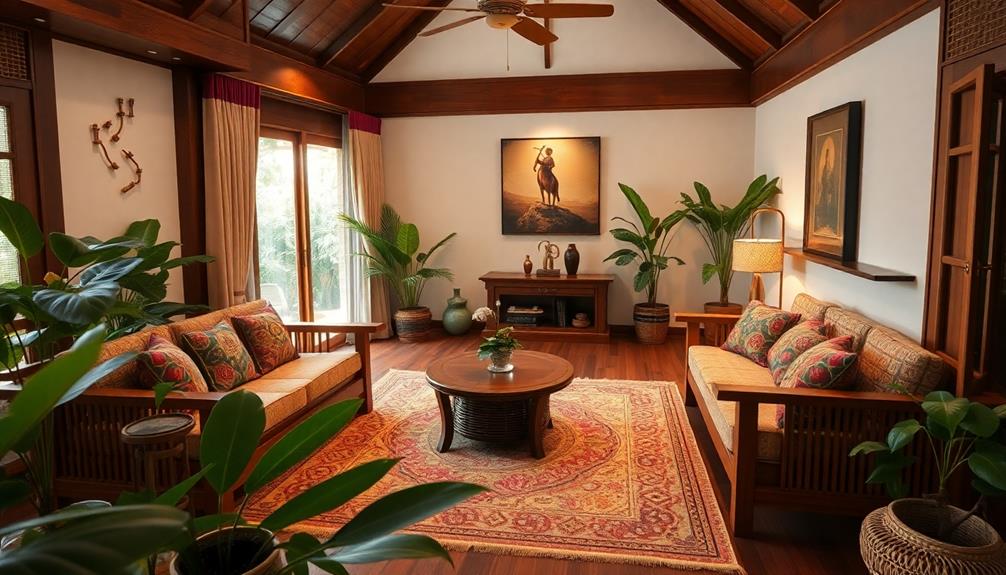
Transform your living spaces into inviting havens by embracing the rich elements of Indonesian design. Start by incorporating vibrant colors inspired by local textiles; deep blues and rich reds can energize your space, creating an inviting atmosphere that draws people in.
Utilize natural materials like rattan and bamboo to not only add warmth but also foster a connection to the environment. Layering textures with rugs, tapestries, and traditional batik prints enhances visual interest, inviting tactile engagement that makes your home feel welcoming.
Don't forget the power of storytelling in your decor. Strategic placement of cultural artifacts, such as traditional masks and sculptures, creates a visual narrative that immerses guests in Indonesia's heritage. This thoughtful arrangement invites exploration and curiosity.
Lastly, follow design principles that emphasize harmony between humans, nature, and artistic expression. By doing so, you guarantee your spaces feel balanced and reflective of Indonesia's vibrant traditions.
With these elements combined, you'll create an inviting atmosphere that resonates warmth and cultural richness, making every corner of your home a delightful experience.
Sustainable Design Practices
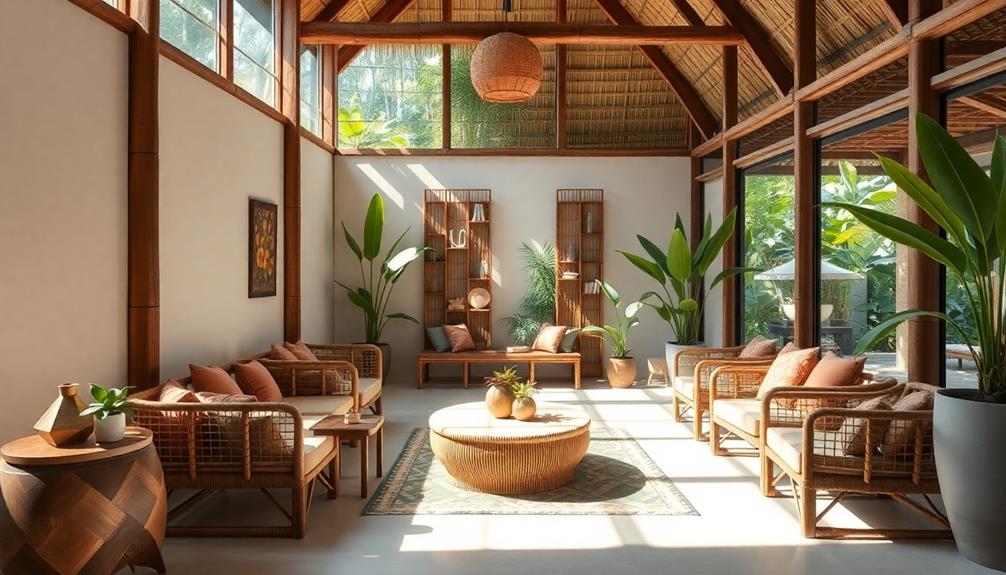
Sustainable design practices in Indonesian interior design focus on utilizing natural materials like rattan, bamboo, and reclaimed wood. By choosing these eco-friendly options, you not only reduce environmental impact but also support local artisans who craft beautiful pieces using traditional techniques.
Here are some key aspects to contemplate:
- Natural Materials: Embrace the beauty of rattan, bamboo, and reclaimed wood to create a warm and inviting atmosphere.
- Traditional Techniques: Support local craftsmanship by using furniture and decor made through age-old methods that enhance sustainability.
- Biodiversity: Incorporate local plant species in your interior gardens, fostering a connection to nature while promoting ecological balance.
- Non-Toxic Textiles: Opt for textiles like batik and ikat dyed with natural dyes, preserving cultural heritage while minimizing harmful chemicals.
Incorporating these sustainable design practices not only beautifies your space but also aligns with a lifestyle that values eco-friendliness.
Tips for Authentic Implementation
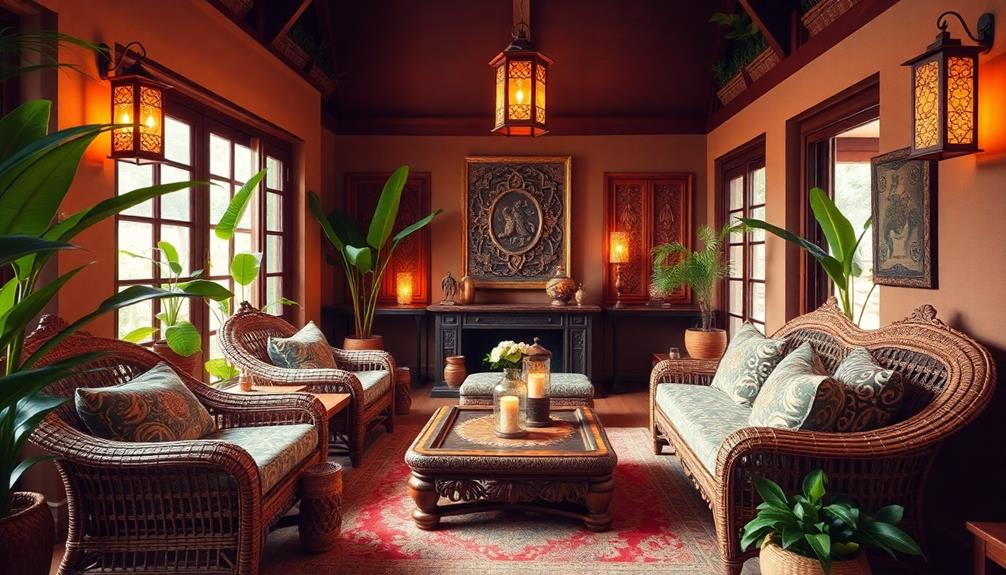
To achieve an authentic Indonesian design, you should embrace local materials like rattan and bamboo, which bring warmth and a natural feel to your space.
Integrating cultural elements, such as traditional art and textiles, not only enhances the visual appeal but also celebrates Indonesia's rich heritage.
Embrace Local Materials
Embracing local materials is essential for creating an authentic Indonesian design that resonates with the rich cultural heritage of the region.
By incorporating sustainable materials, you not only cultivate a warm atmosphere but also honor Indonesia's deep connection to nature.
Here are some tips to help you implement local materials effectively:
- Use rattan and bamboo: These sustainable materials add warmth and reflect the natural beauty of Indonesia.
- Opt for antique wood furniture: This showcases traditional craftsmanship and enriches your space with historical significance.
- Layer textures: Incorporate natural fibers in rugs and tapestries to create comfort and organic beauty throughout your home.
- Select textiles with batik prints and ikat patterns: These choices enhance your cultural identity while infusing vibrant colors into your design.
Integrate Cultural Elements
Incorporating cultural elements into your design not only celebrates Indonesia's rich heritage but also creates a unique and inviting atmosphere. Integrating artifacts is essential; consider using traditional masks and sculptures to tell stories of the diverse cultures within Indonesia. These pieces not only enhance your space but also serve as conversation starters.
Utilize traditional Indonesian textile techniques, like batik and ikat, to infuse vibrant colors and patterns into your interiors. These textiles can be incorporated through cushions, curtains, and wall hangings, adding depth and texture.
Opt for natural materials like rattan, bamboo, and antique wood to promote warmth and sustainability. Arrange your furniture following traditional principles that emphasize balance and harmony, reflecting the relationship between humans, nature, and the divine.
Here's a quick guide to help you integrate these elements effectively:
| Element | Implementation |
|---|---|
| Artifacts | Use masks and sculptures |
| Textiles | Incorporate batik and ikat |
| Natural Materials | Choose rattan and bamboo |
| Furniture Arrangement | Follow traditional principles |
| Textures | Layer rugs and tapestries |
Frequently Asked Questions
What Is an Authentic Interior Design?
Authentic interior design blends cultural elements with modern aesthetics. You'll find natural materials, vibrant colors, and intricate patterns that reflect heritage, creating spaces that tell stories and foster balance, comfort, and sustainability in your environment.
What Are Traditional Materials in Interior Design?
In traditional interior design, you'll find materials like rattan, bamboo, and antique wood. These elements create warmth and connection to nature, enhancing the space's character while promoting sustainability and showcasing skilled craftsmanship.
Conclusion
Incorporating authentic Indonesian design into your space not only showcases its rich cultural heritage but also promotes sustainability. Did you know that over 70% of Indonesian artisans rely on traditional techniques passed down through generations? By choosing local materials and crafts, you're not just decorating—you're supporting a thriving community. Embrace the beauty of balance and harmony in your home, and let the vibrant colors and textures of Indonesia transform your environment into an inviting sanctuary.
